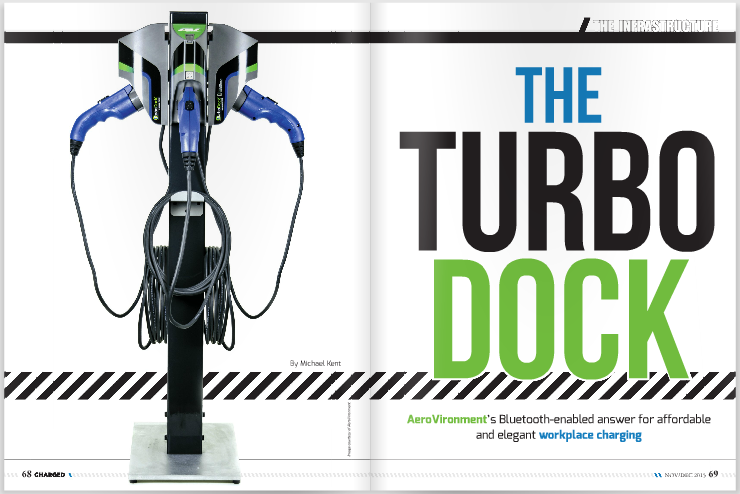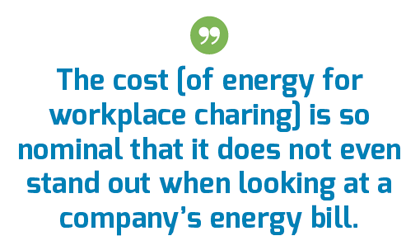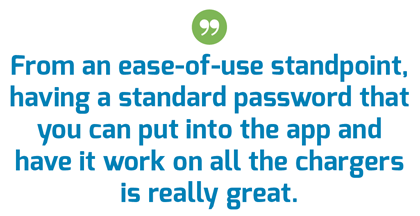Workplace charging is growing quickly in popularity, and it’s encouraging more and more drivers to go electric. Survey data and reports continue to pile up affirming that pushing for more workplace charging is one of the most effective ways to accelerate widespread plug-in vehicle adoption.
According to an August 2014 Department of Energy survey, employees of companies that offer charging stations are 20 times more likely to drive a plug-in vehicle. The study included more than 300 work sites across the US that provide charging access, and 90% reported that their stations are fully occupied at least five days a week.
Many companies that begin to roll out charging spots are noticing a compounding demand – the more stations are installed, the more employees start driving EVs. So, from an industry growth perspective, it’s critical to ensure that providing more and more charging spots for employees is as pain-free and low-cost as possible.
The building energy analytics firm FirstFuel recently did an analysis of utility meter data, and found that the cost to maintain 10 charging stations per year accounts for less than 4 percent of the energy bill in an average 100,000-square-foot commercial office building. “The cost is so nominal that it does not even stand out when looking at a company’s energy bill,” explained Indran Ratnathicam, FirstFuel’s VP of Marketing and Strategy on GreenTechMedia.com. “For those worried about the less than 4 percent increase in energy costs, they should also consider that the same average office building in the FirstFuel database is already wasting about twice that amount based on poor operations. A few low-cost lighting controls and tighter building HVAC start-stop times and set-point controls added to the EV charger setup expense could turn this investment into both a crowd-pleaser and a net financial gain in a matter of months.”
With the cost of operation nearly negligible, the focus of streamlining workplace installations centers on reducing initial investment and administrative burdens. To that end, California-based AeroVironment recently launched the TurboDock modular commercial charging station. Controlled through a smartphone app via Bluetooth, the TurboDock charges at Level 1 (12 amps/120 volts), or Level 2 (16 amps/240 volts).
AeroVironment is now the preferred home charging supplier for seven global automakers with a line of charging systems that also includes the 240 V TurboCord and the EVSE-RS station. Charged recently chatted with Jonah Teeter-Balin, Director of Product Marketing, to learn more about how the TurboDock was designed with the workplace in mind.
Charged: There are many different ways to implement EV charging in commercial settings. Can you describe the driving principles behind the design of the TurboDock?
Jonah Teeter-Balin: When we were developing the TurboDock, we looked at the market and saw a split between the expensive high-end networked workplace charging solutions and the very basic non-networked solutions (such as AeroVironment’s EVSE-RS products). After looking at many studies and talking to customers, we found that most users in workplaces are not using all of the features that come with the expensive networked solutions. However, they wanted more control than the basic stations offer, simply to prevent people who don’t work at the company from accessing the charger. That was a really important insight for us.

We also thought a lot about the charging times. When you’re coming to work and charging, you really have around four to eight hours. A Level 2 16-amp charger, which the TurboDock is, will deliver about 12 miles per hour of charge. If you look at the Department of Transportation data, the typical one-way commute is about 20 miles or less for 77% of drivers. Some people go longer, obviously, and the TurboDock can provide about 48 miles of range in a four-hour period. This means that almost everyone will fully recharge from their commute, even many extreme commuters with more than 35 miles one way will be covered.
We were able to validate the data by talking to one of our large customers who offered 30-amp Level 2 charging to employees. While the average amount of time people were plugged in at work was about 3.5 hours, the average amount of time they were actually charging was only an hour. The conclusion is that, clearly, workplaces should not be paying the additional costs of 30-amp hardware and infrastructure.
Additionally, the TurboDock can also be configured for Level 1. You can do many ports on Level 1 and allow people to stay plugged in all day, or have a mix of Level 1 and Level 2 ports. This really helps to drive down installation costs, which are perhaps the biggest hurdle to adoption.

Charged: Can you describe how the mobile app and Bluetooth connectivity work? Why did you decide to use Bluetooth, and not WiFi or cellular connectivity?
Teeter-Balin: Most smart chargers are cellular connected. That enables a lot of features, but you have to pay a connection fee, or access fee, on a monthly or annual basis. That is a problem for a lot of customers. The great thing about Bluetooth is that you can have the access-control features that a lot of people want, but without connectivity fees and cellular modem costs. Because we know that the vast majority of EV drivers have a smartphone, we can rely upon that connection to provide a communication out from the charger, and remove the need for cellular connection in the charger.
We simply employ a mobile app to provide that access control and configuration. So, the app drives the setup and configuration of the charger. The admin will connect to each charger, and can choose from a few different options for access control. You can configure each charger individually and provide a unique password for each employee to charge, or you can provide one password for a larger group of people. So you can set the same password for all the chargers at the company, then easily change it if you need to at some point.
Each charger can store up to 20 individual user profiles. That can be individual users, or 20 groups and subgroups. Basically, 20 different passwords. So if you have an employee who works in another building and they want to come charge, you can enable them to do so, or prevent it.
From an ease-of-use standpoint, having a standard password that you can put into the app and have it work on all the chargers is really great. That’s how we have it set up at our facilities at AeroVironment, one password for all employees. You can also disable access control on one or more ports for guests, or very easily turn off all passwords for some period of time to allow anyone to charge – during a weekend open house, for example.
So, Bluetooth is a great option to enable simple and easy access control. We evaluated WiFi, and while I think there are some charging applications where it works well, in the commercial setting it’s problematic. To get and maintain access on the network often requires assistance from the company’s IT department, which adds another layer of complexity. And many times the parking lots are out of reach of the WiFi networks. In the end, we found that using the connection in the phone was the right way to go for the initial product launch.
Charged: What are the installation options for the TurboDock?
Teeter-Balin: There are a variety of wall-mounted and pedestal-mounted options, all very simple. The pedestals can mount up to four different chargers, and they have some embedded features that enable easy installation by the electrical contractor at the workplace. AeroVironment’s installation team has done thousands of residential and commercial charging station installations over the years, so they are a really great asset for us when we are designing products. Their expertise really helps to identify all of the possible challenges that can be encountered when installing these in the workplace.
Users also choose to configure the TurboDock as Level 1 or 2 at the time of installation, because the breaker needs to be sized for the operation of the charger. It’s one unit that can be either Level 1 or 2, which makes it really easy for our channel partners.
Charged: Beyond the workplace, what other commercial settings do you think the TurboDock is well-suited for?
Teeter-Balin: We think it’s ideal for places like hotels, resorts, private parking lots, and airports. You can easily install it any place where you want to provide access-controlled or open-access chargers.
For hotels and resorts, we see access control operating in a couple of different ways. One is to have an access code that they can hand out to guests and change it periodically. Then you can also have another access code that’s for more premium guests or staff that doesn’t change as much. So they’ll typically set up a couple of different passwords, update one regularly, and the other won’t change very often.
The TurboDock is also great for airports, because in that use case, again, you’re not really concerned with the charge rate. You’re typically there for at least 24 hours, and a cost-effective Level 1 charger is going to work great there. We see a lot of airports installing Level 1. Some also install a combination of Level 1 and 2. And access control is less important in that kind of environment, because if you’re parking you’re already going through a toll collection system. Some have a premium for EV charging and others have a discount.
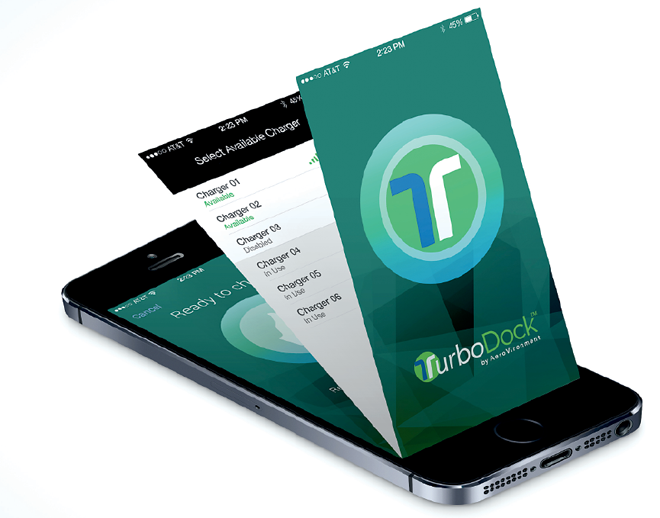
Charged: So AeroVironment now has three product lines for different Level 2 solutions?
Teeter-Balin: Yes, we have three different options and a number of different variants within them, when it comes to our Level 2 portfolio.
The EVSE RS is our 30-amp Level 2 station, used for variety of residential, public and workplace applications.
The TurboCord is our second-most recent product, launched about two years ago. It’s a great product to include in the vehicle because it gives immediate charging options to new EV buyers. When they come home they can charge immediately on Level 1, and if they have a 240 V outlet – or get one installed – then they have Level 2 charging with the same cord that came with the car – they just need to put on the adapter. It removes the added hassles and expense of buying another Level 2 charger, which delivers a better buying experience. And we definitely believe that the overall EV experience is better if you have Level 2 charging at home. It’s a necessity for BEV owners. We also see customers who like the added convenience of both a wall-mounted charger and a portable cord set. So TurboCord is a great value proposition.
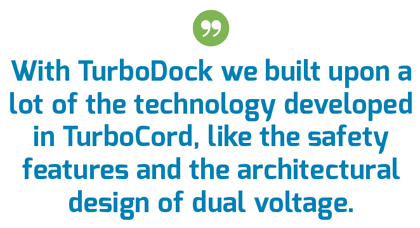
Then, with TurboDock we built upon a lot of the technology developed in TurboCord, like the safety features and the architectural design of dual voltage. We repackaged it for the commercial market and added Bluetooth access-control features.
Charged: Some charging solutions now have advanced smart grid capabilities and the ability to throttle charging during demand peaks. What is AeroVironment’s position on these types of options? Are you looking at the possibility of pushing out more features for the TurboDock via app updates?
Teeter-Balin: We’re certainly looking at more advanced charging features very closely, and we think there is value there. However, in doing our research, we found that there are not a substantial enough number of users currently looking for that kind of feature. We certainly think there are advancements that could be really important to the industry long-term. As you get broader and broader EV adoption, there will be a need to mitigate the demand charges at the workplace, for example. But, ultimately, that’s more of a coming problem.
With TurboDock, we wanted to introduce a product to the market that serves an immediate need, that’s affordable and that meets the requirements for access control. But we definitely believe that our technology is really just getting started, and we have a lot of other features that we can drive with this platform.
This article originally appeared in Charged Issue 22 – November/December 2015. Subscribe now.






